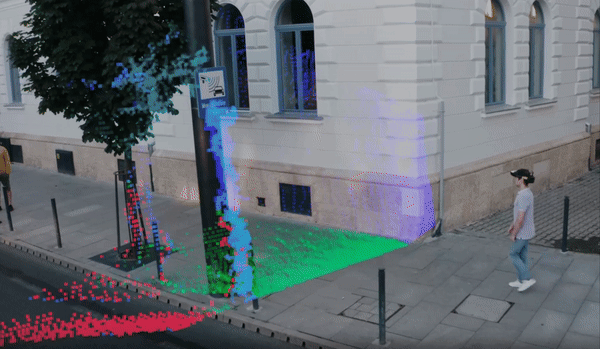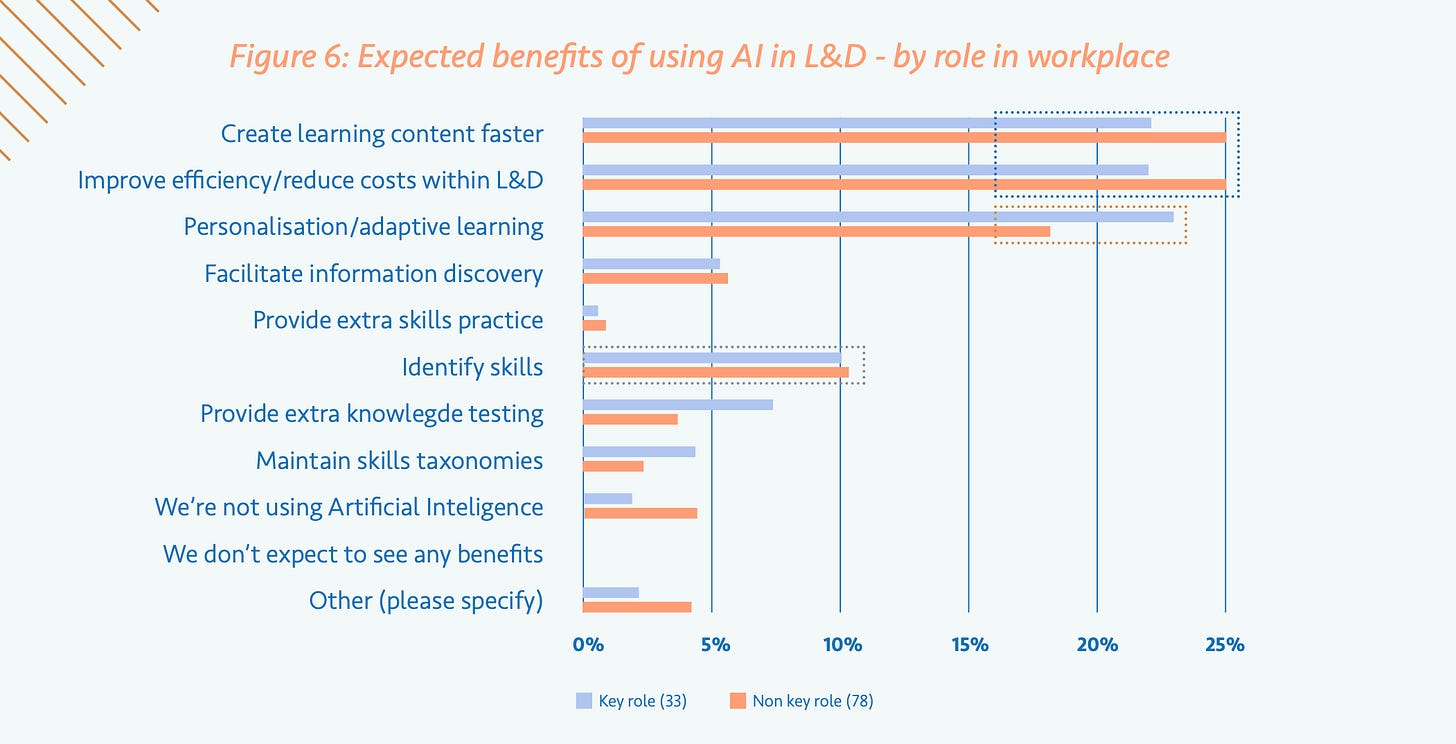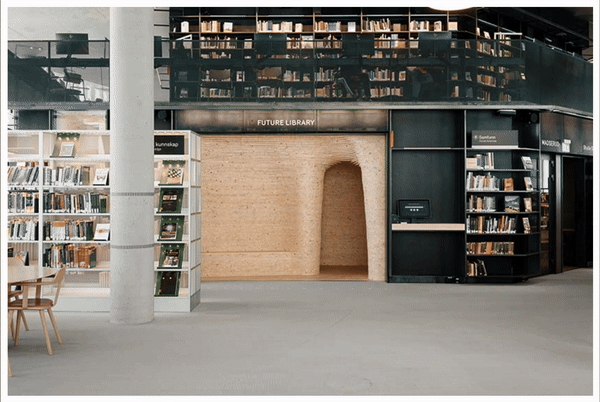I didn’t particularly want to write about AI, but I keep finding these projects that mesmerised me, and some thoughts came to mind, so here we are…
This won’t cover the ins and outs because, who am I kidding? I’ve got no clue about AI and how it works. Some pretty intelligent people are still trying to figure it out, which does not necessarily ease my mind.
Not knowing doesn’t mean I cannot stop and wonder. Because OMG, the stuff we can do today with the help of this technology. 🤯
So take this for what it is: A curious exploration. Expect errors, and if you can move behind them, share the thoughts and questions that linger with you in the comments.
Alright, humans, let’s get to it, shall we?
Let AI do what we cannot do.
I picked five mind-blowing AI projects that stopped me from scrolling and got me thinking. What’s so special about them? They solve real-world problems that were deemed unsolvable before.
TL;DR: There are 338.000.000 visually impaired people and only 20.000 guide dogs.
The AI-powered solution: The .lumen Glasses scale self-driving technology down to something that can be worn on the head. They will understand obstacles above or below the ground and keep visually impaired people from them. They indicate safe walking paths and help avoid roads, puddles, or mud.
TL;DR: Every 15 minutes, an elephant falls victim to poachers. That's around 35,000 casualties per year.
The AI-powered solution: TrailGuard AI, a system created by Resolve, a US-based environmental organization, employs tiny cameras powered with tech from Intel to monitor endangered species and spot poachers. The system uses either cell or long-range radio signals to transmit the images to authorities’ phones in as little as 30 seconds.
—ALPHAFOLD ⚛️
TL;DR: Currently, over 200 million proteins are known, with many more being discovered every year. Each one has a unique 3D shape that determines how it works and what it does.
But figuring out the exact structure of a protein can sometimes take years and hundreds of thousands of dollars, meaning scientists could only study a tiny fraction of them. This slowed down research to tackle disease and find new medicines.
The AI-powered solution: AlphaFold 2 algorithm can predict a protein shape from a sequence of amino acids. AlphaFold 3 goes beyond proteins to a broad spectrum of biomolecules, including DNA, RNA, and even small molecules, also known as ligands, encompassing many drugs. This leap could unlock more transformative science, from developing biorenewable materials and more resilient crops, to accelerating drug design and genomics research.
—FARMBEATS 🌱
TL;DR: Agriculture is under pressure all over the world. Water scarcity, agricultural pollution, increased demand for food, and lack of arable soil are challenges that farmers face daily.
The AI-powered solution: FarmBeats uses sensors, drones, data analytics, AI, and connectivity solutions to enable precision agriculture, improving yield while reducing resource consumption. This is done with affordable sensor technology, drone cameras, and no Wi-Fi connectivity.
—POLLINATOR PATHMAKER 🐞 🐝
TL;DR: Many plants need pollinators to help them reproduce. It’s not just the appearance of flowers that attracts them, but also when they appear: flowers bloom when their favourite pollinators emerge.
Pollinator species also have different foraging styles. Beetles explore patches more randomly, while bees remember the locations of the flowers they visit, zapping along the most efficient flight paths, or ‘traplines’.
The loss of a single pollinator species can mean the end of a plant species.
The AI-powered solution: Working with horticulturalists, leading pollinator experts, and an AI scientist, Ginsberg devised an algorithm built using pollinator species and the plants they forage from as input– to calculate the planting design of a garden. The tool selects and arranges plants to suit the different preferences of their visitors.
WOW. Ok, let’s stop for a second.
What do all these projects have in common besides AI?
They all solve a wicked problem that humans had a hard time solving without technology.
What are the wicked L&D problems AI can help us solve?
Let’s come back home. What do we use (mainly generative) AI for in L&D?
Egle and Donald asked this question, and this is what they have found out:
The two main benefits we expect from AI are creating content faster + saving costs.
Not to say there’s anything wrong with this, but we’ve been at it for ages.
We’re drowning in content libraries that no one uses. And it isn’t working.
We know that.
Here we are, facing one of the most revolutionary technologies ever, and the first thing we want to use it for is to create more content faster.
Why is that? What is keeping us stuck there? 😵💫
The answer is, unsurprisingly, not a straightforward one.
There’s a parade of reasons why AI isn’t more widely experimented with in our industry and why, even when we do decide to use it, we choose to layer it on top of current ways of working instead of innovating.
We could pick apart any of these reasons, but in my limited and flawed experience, one of them stands out:
Our inability to get to the bottom of it. To find the right problem to solve.
Without a ‘wicked problem’ to focus on, we default to the stuff that’s been keeping our heads down and busy for the past decades: churning out content. And we are using AI to do it faster and more efficiently.
In isolation, there’s nothing wrong with this. We’re optimising workflows, and that’s ok. If there’s a way to produce (better) quality work faster, let's get to it!
What’s wrong is that we use this fascinating technology, which has revolutionised other industries, to put out candles while surrounded by massive bonfires.
Read any industry report of the past ten years, and you’ll find plenty of bonfires:
—The fact that we (still) often interrupt workflows for training programs that are not transferable to participants daily tasks once they get back to their desks.
—The fact that very few decisions we take are based on data and how so many organisations lack the data needed to understand workforce skill levels, gaps, and development priorities.
—How crazy hard it is to reskill and upskill at scale, even if you know that those gaps are. And how increasingly hard it is to find talent for specific skill sets, especially in tech, digital, and green sectors.
—We’re not adapting our organisational cultures, policies and ways of working to the needs of the upcoming generations. Turnover and disengagement rates keep rising, particularly among younger generations who seek continuous development and work-life balance.
And the list goes on, and honestly, it’s pretty depressing.
So, the issue here is not that we lack wicked problems. The issue is that we either ignore them or cannot get to the bottom of them. We don’t fully understand them; we struggle to bring the data and the concrete action plans to the big boy’s table.
And so we continue to create content. But faster.
No wonder the illuster minds of our industry keep drilling down the performance consulting approach, and we keep asking each other, “How can we get leaders to truly value what we do?”
That’s also why I wrote a LinkedIn article this week about the tools we can use to narrow down the problem to be solved before we raise our pens to draw a solution.
Can I tell you a secret? I am tired of this conversation…🫣
So, I went on looking for inspiring AI-powered learning solutions.
It was so hard to find some juicy ones. Like really, really hard…Let’s have a look.
We can already do some pretty cool stuff with AI in L&D, beyond creating more content.
🧑✈️ Performance Support Copilots
Remember all that excellent content you create and curate that lies dormant in your LMS and content libraries? 😁 Copilots can retrieve this information fast and make it accessible in the moment of need.
—Your people get answers to questions fast, like Google, but internal.
—Based on the search function's data, you learn what information is incomplete or missing so you can continue to create and curate relevant content.
🤖 Chatbots for 1:1 support
AI-Chatbots provide right-on-time support; they maintain anonymity so that users can get help without fear of judgment. While data is anonymised, organisations can access general trends and insights to design and deploy informed solutions.
They can be used for several purposes:
—As companions to DEI policies and projects on harassment, different forms of exclusion, and well-being support.
Woebot Health Copilot is an end-to-end enterprise solution aiming to increase access to mental health support and improve business outcomes. Another example is Cyber Smart Buddy, which helps users deal with cyberbullying.
—As a 1:1 Coach or Mentor to provide real-time support and guidance tailored to their individual needs. Imagine a Mentor Bot trained on your subject matter experts in any field and accessible anytime with any question.
Replika Replika is an AI chatbot designed to provide emotional support and conversational practice. While it's not a traditional coaching platform, it serves as a digital mentor that helps users reflect on their thoughts and feelings.
—A bit of an edge case, but too good not to share: You can use AI bots as a reflection partner. To surface insights, lessons learned, and takeaways from experiential learning, or learning-by-doing. Too often we hear “I haven’t learned anything this month”, when what they are trying to say is “I haven’t attended a format training this month.” Thruth is, reflection over a learning experience has always been a wicked problem for learning designers. Not anymore!
Riff is designed to augment individual reflection with questions that invite the learner to go deeper in the initial exploration of their experience. Read more about Riff from its creator, Leticia Britos Cavagnaro, from d.school.
💻 AR/ VR practice sandboxes
AI-powered VR and XR simulations and immersive learning experiences that:
—Mimic real-world scenarios
—Provide hands-on practice
—Give instant feedback in a risk-free environment
📊 Skills assessment and mapping
By analysing existing roles, employee performance data, and industry trends, AI can map employee’s skills and identify the gaps so that we can make more strategic workforce planning decisions.
Example: Eightfold
✨ Making existing content more accessible
There’s tons of content buried in podcasts that hearing-impaired people won’t access. There is so much wisdom in books that visually impaired people cannot access. Not to mention the struggle to provide content in the native language when working across different cultures.
Podwise summarises, outlines, generates mindmaps and transcribes any podcast in minutes. Dexa give you answers to your questions by skimming all the awesome advice in the Huberman Lab Podcast. With Canva you can now translate your content slides in othe language in a click of a button—Ross explains it here.
And if you are AI-in-learning-curious and have scavenged for cool projects, please share them in the comments. I am desperate to find examples that restore my faith in our industry's ability to innovate.
Not everything needs to be so serious all the time. Some things are just for fun.
If you want to kill some more time this Friday, pass by Google’s Experiments.
You can play with 1613 experiments that push the boundaries of art, technology, design, and culture.
Some of my latest favourites are:
Illustrated Haikus, where AI generates the music, fonts, and videos.
Hear the colors in a painting by Vassily Kandinsky and make music with them.
Explore the connection between emotions and art, and browse 25 emotions associated with 1.500 paintings.
Scroobly, where you can create a doodle of yourself and animate it live with the movements of your body.
Reset humanity to basic features.
Too much AI in one go? I hear you.
Suppose you are looking for a palate cleanser after this week’s letter. 🤣
In that case, explore this art project by Katie Paterson, called Future Library.
One thousand trees have been planted in Nordmarka, a forest just outside Oslo, which will supply paper for a special anthology of books to be printed in one hundred years’ time. Between now and then, one writer every year will contribute a text, with the writings held in trust, unpublished, until the year 2114.
Another wonderful example is this Business Insider Documentary about 20 Japanese Businesses Making The Most Expensive Products In The World.
For example, traditional Japanese calligraphy ink from Kobaien, referred to as sumi ink, comes in a solid form. It takes at least four years of production before these ink sticks can be sold, and even longer for the most expensive ones. A 200- gram high-grade ink stick costs over $1,000.
Spoiler: There’s almost no tech in sight. It’s all about years of craft honing. Hours are poured into hand-crafting and caring for products, and business owners are hell-bent on keeping the quality from decades of tradition at their company's core.
Alriiight, this is me saying bye for now! ✌️
This newsletter is how I share what I am learning and discovering with the world, with no paywall involved. If you’ve found something useful here and would like to say “thanks”, buy me a coffee and I’ll feel most appreciated.
Stay curious!
Anamaria











Woo-hoo, what a ride! So many inspiration examples outside my usual route. Thanks for this juice letter!